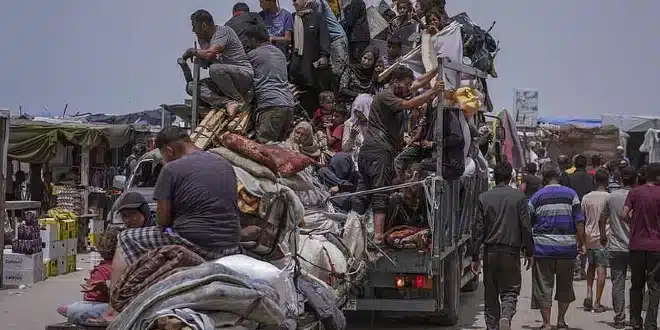Israeli shelling and airstrikes killed at least 37 people, most of them sheltering in tents, outside the southern Gaza city of Rafah overnight and into Tuesday. The same area saw deadly strikes days earlier that ignited a fire in a camp for displaced Palestinians, according to witnesses, emergency workers, and hospital officials.
The tent camp fire has sparked international outrage, including from some of Israel’s closest allies, amid the military’s escalating offensive in Rafah. Highlighting Israel’s growing international isolation, Spain, Norway, and Ireland formally recognized a Palestinian state on Tuesday.
The Israeli military suggested that Sunday’s fire in the tent camp may have been caused by secondary explosions, possibly from Palestinian militants’ weapons. The results of Israel’s preliminary investigation were released Tuesday, with military spokesman Rear Adm. Daniel Hagari stating that the cause of the fire is still under investigation. He added that the Israeli munitions used, which targeted a position with two senior Hamas militants, were too small to have caused the blaze on their own.
The fire, which killed 45 Palestinians according to Gaza health officials, could have also been ignited by fuel, cooking gas canisters, or other materials in the camp. Israeli Prime Minister Benjamin Netanyahu called the fire a “tragic mishap.”
Israel’s offensive in Rafah, which began on May 6, has driven over 1 million people to flee the city, according to the U.N. agency aiding Palestinian refugees. Many were already displaced multiple times in the nearly eight-month conflict between Israel and Hamas. Families are now scattered across makeshift tent camps and other war-ravaged areas.
Recent strikes have targeted areas west of Rafah, where the military had not ordered civilians to evacuate. Israeli ground troops and tanks have been operating in eastern Rafah, central parts of the city, and along the Gaza-Egypt border.
Late Monday and early Tuesday, shelling hit Rafah’s western Tel al-Sultan district, killing at least 16 people, according to the Palestinian Civil Defense and the Palestinian Red Crescent. Seven of the dead were in tents near a U.N. facility about 200 meters from Sunday’s fire site.
“It was a night of horror,” said Abdel-Rahman Abu Ismail, a Palestinian from Gaza City sheltering in Tel al-Sultan since December. He described hearing “constant sounds” of explosions overnight and into Tuesday, with fighter jets and drones overhead. The situation reminded him of the heavy bombing and ground invasion of his Shijaiyah neighborhood in Gaza City in late 2023.
The U.S. and other Israeli allies have warned against a full-scale offensive in Rafah, with the Biden administration indicating this would cross a “red line.” The U.S. has paused shipments of heavy bombs to Israel over concerns they could be used in Rafah. On Tuesday, U.S. State Department spokesman Matthew Miller said the administration does not see Israel’s actions in Rafah as crossing any red lines, describing the offensive as “far different” in scale from assaults on other Gaza population centers.
Last week, the International Court of Justice ordered Israel to halt its Rafah offensive as part of South Africa’s case accusing Israel of genocide against Palestinians in Gaza.
Algeria is circulating a proposed U.N. Security Council resolution demanding a halt to the fighting in Rafah, potentially bringing it to a vote this week. The U.S. has previously vetoed multiple Gaza cease-fire resolutions.
On Tuesday afternoon, an Israeli drone strike hit tents near a field hospital by the Mediterranean coast west of Rafah, killing at least 21 people, including 13 women, according to Gaza’s Health Ministry. Witness Ahmed Nassar said his four cousins and some of their spouses and children were among the dead, and several tents were destroyed or damaged. Most of the victims had fled from the same Gaza City neighborhood earlier in the conflict.
“They have nothing to do with anything,” Nassar said.
Netanyahu has vowed to continue the offensive in Rafah, stating that Israeli forces must enter the city to dismantle Hamas and rescue hostages taken in the October 7 attack that sparked the war.
In its investigation of Sunday’s strike and fire, the Israeli military released satellite images showing what it said was a Hamas rocket launch site about 40 meters from targeted sheds. The alleged launcher did not appear to have been hit. Hagari said Israeli warplanes used the smallest bombs possible, with 17-kilogram warheads, asserting that their munitions alone could not have caused such a large fire. He called the fire a “devastating incident” resulting from “unforeseen circumstances.”
The strikes have prompted more people to flee areas west of Rafah. Sayed al-Masri, a Rafah resident, reported that many families were heading to the crowded Muwasi area or to Khan Younis, which has also suffered significant damage during the conflict.
“The situation is worsening” in Rafah, al-Masri said.
Gaza’s Health Ministry reported that two medical facilities in Tel al-Sultan are out of service due to intense nearby bombing. Medical Aid for Palestinians, a charity operating in the territory, said the Tel al-Sultan medical center and the Indonesian Field Hospital were on lockdown with medics, patients, and displaced people trapped inside.
Most hospitals in Gaza are no longer functioning. Rafah’s Kuwait Hospital shut down Monday after a strike near its entrance killed two health workers.
A World Health Organization spokesperson said casualties from Sunday’s strike and fire “absolutely overwhelmed” field hospitals in the area, which were already running low on supplies for treating severe burns.
“That requires intensive care, electricity, and high-level medical services,” said Dr. Margaret Harris. “We are struggling to have the high-level skilled doctors and nurses because they have been displaced.”
The conflict began on October 7 when Hamas and other militants launched a surprise attack on southern Israel, allegedly killing about 1,200 people and abducting around 250. More than 100 were released during a weeklong cease-fire in November in exchange for Palestinians imprisoned by Israel.
Israel responded with a massive offensive by air, land, and sea, killing at least 36,096 Palestinians, according to Gaza’s Health Ministry, which does not distinguish between fighters and civilians in its count. Around 80% of Gaza’s 2.3 million population has been displaced, and U.N. officials report parts of the territory are experiencing famine.
The fighting in Rafah has severely hindered humanitarian efforts to deliver and distribute aid in southern Gaza.
The Israeli military claims to have allowed hundreds of trucks to enter through the nearby Kerem Shalom crossing since the operation began, but aid groups report difficulties accessing that aid due to the ongoing fighting.
The U.N. has been able to collect aid from around 170 trucks over the past three weeks via Kerem Shalom. Smaller amounts of aid have entered through two northern crossings and by sea via a U.S.-built floating pier, but this falls short of the 600 trucks a day needed by aid groups. The pier is currently being removed for repairs.


